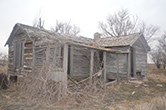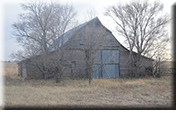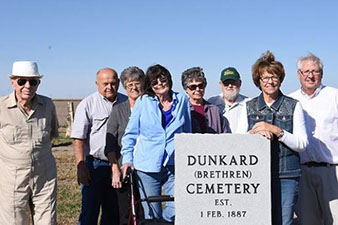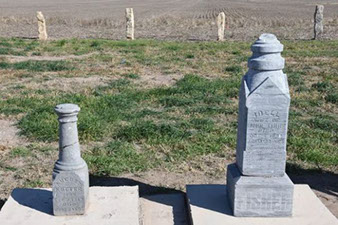

PHILLIPS COUNTY
Colorado
Dunkard Cemetery Story
as featured in the Holyoke Enterprise.
Below is a story about the Dunkard Cemetery that was featured in the Holyoke Enterprise. I want to thank Brenda at the Holyoke Enterprise for allowing me to place the article on this web page. All information contained in this article is the sole property of the Holyoke Enterprise.

Those gathered to see the completed restoration of Dunkard (Brethren) Cemetery are pictured from left, Wilbur Kipp, Larry Poos, Jeanette Poos, Jean Gray, Sharon Thompson, Tommy Thompson, Mary Fulscher and Ken Frantz. — Johnson Publications

Two original headstones were all that remained of the Dunkard Cemetery prior to its recent restoration. — Johnson Publications
DUNKARD CEMETERY RESTORED; UNMARKED GRAVES FOUND
KELLEY SULLIVAN, THE HOLYOKE ENTERPRISE
Two small monuments were all that remained of an almost unknown cemetery located southeast of Amherst in a wheat field until last spring. Spurred by a call from Jean Gray to Tommy Thompson, a restoration project was set in motion.
Gray, former publisher of the Haxtun-Fleming Herald, was researching history of the Haxtun Church of the Brethren for its 100-year celebration. Through her research, Gray found information about Dunkard Cemetery and called Thompson, wondering if he knew anything about it. Thompson, who served as Phillips County commissioner and previously owned Thompson Mortuary, indeed knew of the cemetery.
According to Gray’s research, the early Colorado Brethren first met to organize a congregation northeast of Holyoke in June 1886. There appears to be no record of a church building, but the two monuments remain as proof a cemetery exists.
After the conversation with Gray, Thompson contacted Larry Poos to ask him for help in restoring the cemetery. Poos agreed, and earlier this year the preservation project began.
Poos and Thompson said they had talked about restoring the cemetery when they were county commissioners together in the late 1980s but just didn’t get around to it.
“Dunkard was a bigger job than we first thought,” said Poos. “When we started, there was 18 inches of dirt that had blown in over 115 years.” After being farmed around for many years, the ground was extremely hard and a backhoe was needed to break the ground.
While searching the area, they located a cement corner of a burial plot. After digging out the dirt, they discovered the entire plot of the Elder family.
Julia Elder and four of her children were buried in the plot with the 1-foot-high foundation around it. According to obituaries, three of the Elder family died from typhoid fever within a few months of each other.
The Elder family graves were found marked by four little pieces of cement buried under the dirt, said Poos. The fifth family member was found using grave divining.
“We were two-thirds done with the project when we found out about grave divining,” said Poos. A family member suggested to search for the graves using divining.
Poos, who has practiced the age-old art of water divining for many years, thought finding a grave this way would be impossible, he said. He searched the internet and discovered that searching for graves is very similar to water divining.
Divining, also called witching, is a method used by some to find underground objects of interest. There are variations in how divining is performed, however the most common way is with two bent rods of metal.
Using a pair of simple L-shaped metal rods, one rod is held in each hand, with the short arm of the L held upright, and the long arm pointing forward. In general, when something is found, the rods cross over one another, making an X over the found object.
After studying up on it, Poos went to the cemetery to give it a try and sure enough it worked, he said. Using two brazing rods, he can locate a body, determine its gender and whether it is an adult or child.
“Each person has different movements of the rods,” explained Poos. When he is divining, the rod in his right hand moves inward when he locates a female, while the left-hand rod moves inward for a male. He has marked the grave sites at Dunkard with blue and pink flags representing males and females respectively.
The last known person to be buried in the cemetery was in 1901, said Poos. “There were six graves that we know of when we started, but after divining we found 31 unmarked graves,” he added. The new boundaries doubled the size of the cemetery.
They know of two graves that have been moved, noted Poos. One is for Jacob Furry, who was one of the first county commissioners, he added. A street in Holyoke is named after Furry.
A brief history of the Dunkard church and cemetery published in the 1993 edition of “Phillips County History” notes that John Fisher recorded the sale of one acre of land to the Dunkard church and congregation in September of 1899. The cemetery is located a quarter mile north of County Road 30 on County Road 55 near Amherst.
Fulschers have owned the ground since 1945. They always knew there was a cemetery there and were careful to farm around it, said Mary Fulscher.
A new monument has been constructed recognizing the Dunkard Cemetery. It has a date of establishment on the front and names and dates of those known to be buried there on the back. New headstones were made and placed in the Elder family plot.
Kansas limestone fence posts were used to create a boundary around the area. The Haxtun Soil Conservation District donated trees to surround the north and west sides of the cemetery, while Pheasants Forever members helped with planting.
The restoration was complete in September. Thompson said he is glad it is done and that the cemetery will be preserved. He is thankful for all the donations and help from others to complete the project.
Gray noted that she saw the cemetery last spring before the restoration began. She is pleased to see Dunkard restored. “It looks great,” she said. “Much better than I anticipated.”
Fulscher noted that it is not necessary to request permission to visit the cemetery. There is no real road leading to it, just a small path of tire marks. The public is welcome to visit, being mindful of when crops are in the field.

All materials contained on these pages are furnished for the free use of those engaged in researching their family origins. Any commercial use, without the consent of the host/author of these pages is prohibited. All images used on these pages were obtained from sources permitting free distribution, or generated by the author, and are subject to the same restrictions/permissions. All persons contributing material for posting on these pages does so in recognition of their free, non-commercial distribution, and further, is responsible to assure that no copyright is violated by their submission.
Last updated December 2018
